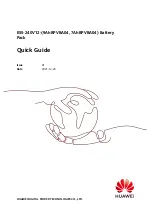
3
■
Features of Twicell Batteries
Extended service life and superior economy
Despite discharge capacity that is virtually equal to that of
conventional dry cells, Sanyo Twicell batteries feature
minimal internal resistance and exhibit excellent discharge
characteristics under high-rate discharge current conditions.
With output power much higher than that of dry cells. In
addition, even though the batteries are stored for a long time,
the original capacity is almost recovered by repeated
charging/discharging, offering excellent storage
characteristics.
Wide-ranging lineup and interchangeability with
dry cells
Customized assembled batteries tailored to specific
equipment space requirements are also available.
Excellent high-rate discharge performance and
overcharge/overdischarge capability
Sanyo's original electrode manufacturing process and current
collectors minimize internal resistance, which in turn enables
high-rate discharging and guarantees stable discharge
voltage.
Improved reliability with wide operating
temperature and humidity ranges
In addition to displaying only minimal variation in performance
over a wide temperature range, their totally-sealed
construction gives Twicell batteries high resistance to
humidity. Sanyo Twicell batteries are manufactured under
strict quality control conditions, and undergo 100% inspection
before shipment. This assures superior reliability.
Simple to maintain and strong
The special sealed construction eliminates the need to
replenish the electrolyte, for easier maintenance. As Sanyo
Twicell batteries may be installed in any direction in
equipment, they are exceptionally easy to handle. Moreover,
Twicell batteries employ a rigid metal casing for superior
resistance to shock and vibration.
■
Principle of the Nickel-Metal Hydride
Battery
The nickel-metal hydride battery makes electrochemical use
of the reversibility of the hydrogen absorption/release
reaction in the hydrogen absorbing alloy. The battery uses a
nickel oxide compound for the positive electrode, a hydrogen
absorbing alloy for the negative electrode, and an aqueous
alkaline solution for the electrolyte, which includes such
constituents as potassium hydroxide (KOH). During
charging, the electrolytic reaction of water causes the
hydrogen, which forms in atomic form on the surface of the
hydorgen absorbing alloy in the negative electrode, to
diffuse into and be absorbed by the alloy (charge reaction).
During discharge, the absorbed hydrogen reacts with
hydroxide ions at the surface of the hydrogen absorbing
alloy to once again become water (discharge reaction). In
other words, the active material of the negative electrode
reaction is hydrogen, and the hydrogen absorbing alloy acts
as a storage medium for the active material. Sanyo has
developed a hydrogen absorbing alloy, which absorbs a
large quantity of hydrogen at low pressure and which can
also release it. Sanyo employs this alloy in the Twicell.
High Cost Performance, Stable Discharge Voltage
Powerful Twicell
Gasket
Negative electrode
Positive electrode
Positive electrode
insulation washer
Negative
current
collector
Positive
current
collector
Casing
(
○
−
negative
terminal)
○
+
Positive terminal
(with built-in gas release vent)
Separator
Cover plate
Seal plate
Rubber plate
Spring
Structural Design






























